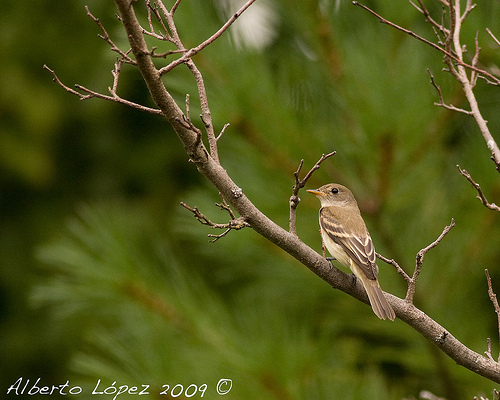Empidonax flycatchers… you can’t live with them, you can’t build a complete life list without them. As countless as the stars above have been the brillant birders brought low by these humble homunculi, these tiny little iterations on an undistinguished theme. Such has become the fate of our friend Alberto Lopez, late of Puerto Rico but recently relocated to Ithaca, NY (just in time for fall too!) Alberto is an ace photographer; many of his images helped support our May 2009 Puerto Rico Month series, notably his shots of the stealthy Puerto Rican Screech-owl. You can see some of his superb images at his old blog or eagerly await his new one. To tide you over, he’s offered us one excellent image along with a plea for help:
I just moved from Puerto Rico to Ithaca… and as you might guess I am going mad birding every chance I get. Lots of new species for me, trying to learn their calls and fieldmarks wow! I feel like I’m starting all over again, I was already use to going birding without a field guide but now its a must! And ive been able to id almost everything but this little flycatcher. This photo was taken in Sapsucker Woods.
Alberto has his own thoughts about what species this bird is but alas cannot flesh out the sighting with any information about the bird’s vocalization or behavior. Do you dare try to identify this empid based on timing, geography, and the photo below? I invite any and all insights in our comments section but be warned: I have no freaking idea what flycatcher this is!

And for those of you who don’t know why birds like this are so maddening, allow me to shed some light on just what an Empidonax flycatcher is.













Oh dear, it seems the sound file of the bird’s song that you’ve surely linked to in the post isn’t working properly.
There is a sound file somewhere, right?
What, there isn’t?
Geez.
Okay, it is neither a Least nor a Yellow-bellied, leaving us with Willow, Alder and Acadian. I would also guess it is a hatch-year bird.
I lean towards Willow by intuition alone and the wings might be a bit too short for Acadian (additionally, I would guess Acadian is a bit unusual in Ithaca). But really, this is as far as I’d venture.
It it is an empid, it’s a “Traill’s”, but I can’t even reliably convince myself that it is Empidonax over Contopus.
My first impression was that it is a Empidonax because of its size, it seemed relatively small, I also had a brief chance to see a Contopus Flycatcher that same day and it had a darker coloration and was larger. I am stumped!
This is probably lucky for me that I just posted this species (assumably) on my blog a few days ago. Lack of eye-ring/post-ocular spot and completely yellow lower mandible puts this in the “Traills” complex. Dusky, Hammond’s, and Gray have smaller structures and elongated, daintier bodies. Cordilleran/Pac-Slope have yellow lower mandibles but have eye-rings as well. Least has an eye-ring and post-ocular teardrop. Structure also eliminates other birds like Acadian. Contrasting throat to head also is good for “Traill’s.” Wings look short and tail looks long, so I believe this is a Willow Flycatcher. Overall brown tones and large head help as well. From my experience, I would say Alder is more contrasting in the throat area than this bird. Boy, I hope I’m right!
If I had seen it in Idaho, I would have called it a Willow Flycatcher. Buenas suerte!
Willow is winning!!!
Thanks, Gracias!!!
This looks like a Willow/Adler. The eyering is quite weak, and the primary projection (length of the primaries past the end of the tertials on the folded wing) is moderate. We can easily eliminate Least & Yellow-bellied Flycatchers, which both have strong eyerings. Acadian has a longer bill and is more greenish on the back. Willow and Alder are best told apart by voice and can be difficult or impossible to separate in the hand. A beautiful photo – wish I’d taken it.